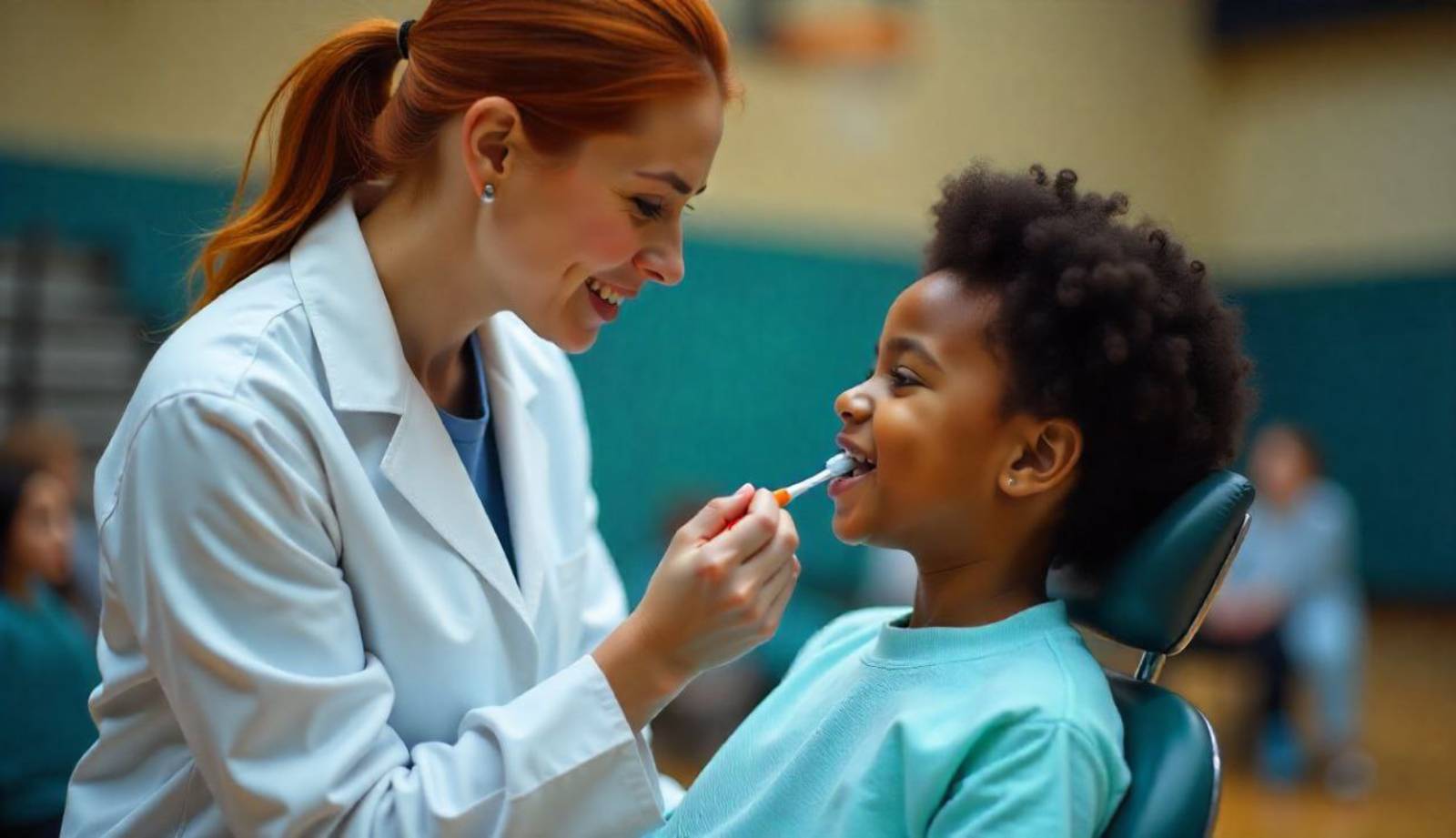
Little Smiles, Big Transformations: A Pediatric Dental Restoration Success Story
At our clinic, we believe that every child deserves a bright, healthy smile — one they can proudly share with the world. A confident smile in childhood lays the foundation for a lifetime of positive oral health habits and self-esteem. Pediatric dentistry is not just about fixing teeth; it’s about nurturing trust, comfort, and lifelong confidence in young patients.
This is one such heartwarming story from our practice — a true transformation that reflects the importance of early intervention, compassionate care, and comprehensive pediatric dental treatment.
The Challenge: Severe Tooth Decay in a Young ChildA young child visited our clinic with one of the most common yet serious pediatric dental issues — Early Childhood Caries (ECC). The decay had affected several front teeth, causing visible discoloration, structural damage, and inflamed gums.
Early Childhood Caries is a rapidly progressing form of tooth decay that can develop soon after the eruption of the first teeth. It is typically caused by:
-
Frequent consumption of sugary snacks or drinks
-
Bottle-feeding at night (especially with milk or juice)
-
Poor oral hygiene or irregular brushing habits
-
Early exposure to cavity-causing bacteria
In this child’s case, the extent of decay was severe. The affected teeth had lost much of their natural structure, making everyday activities like eating and speaking uncomfortable. Beyond the physical discomfort, the appearance of decayed front teeth had begun to impact the child’s confidence and willingness to smile.
What many parents don’t realize is that gum inflammation, like the kind seen here, is not just a local problem. Chronic oral inflammation in children can have systemic effects — potentially influencing overall health, appetite, and even sleep quality.
Diagnosis and Treatment PlanningAfter a thorough clinical examination and radiographic assessment, we identified extensive decay involving the upper anterior teeth and early signs of inflammation in the surrounding gums. Fortunately, with timely intervention, the situation was entirely reversible.
Our approach was centered on three key goals:
-
1. Preserve natural tooth structure wherever possible
-
2. Restore aesthetics and function
-
3. Ensure long-term comfort and prevention of recurrence
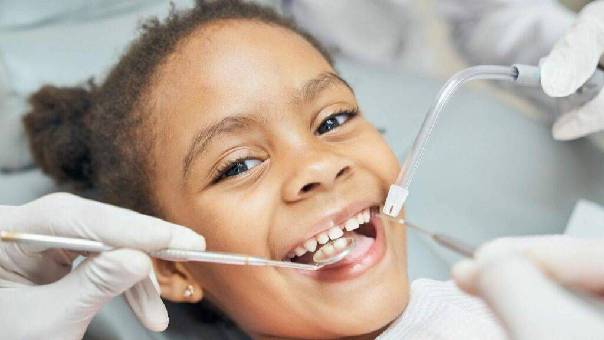
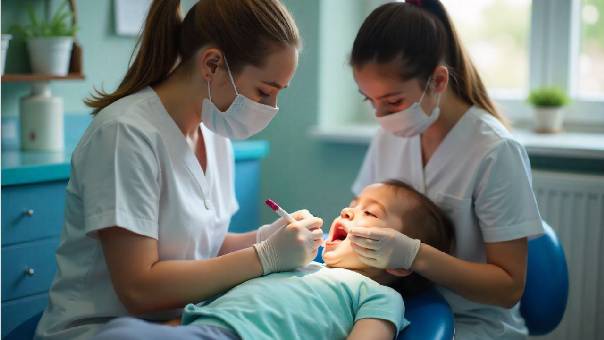
The treatment plan included:
-
Gentle removal of all decayed tissue
-
Pulp therapy (if the decay had reached the pulp or nerve)
-
Restoration of tooth structure using aesthetic pediatric crowns
-
Fluoride therapy for strengthening enamel and preventing further decay
-
Parental guidance on home care and diet modification
We always ensure that every pediatric case is approached with minimal discomfort. Child-friendly communication, gentle techniques, and a calm environment are the cornerstones of how we treat young patients.
Step-by-Step: The Restoration ProcessThe entire treatment process was carried out in a manner that made the experience as positive as possible for the child and reassuring for the parents.
-
1.Cavity Removal and Cleaning
All decayed areas were carefully removed under local anesthesia, ensuring complete comfort. We used modern, minimally invasive techniques to preserve as much healthy tooth structure as possible.
-
2. Pulp Therapy
For teeth where decay had reached the pulp, pulp therapy was performed to save the tooth. This procedure allowed us to retain the natural roots and maintain the tooth’s position — crucial for proper spacing, speech, and chewing function in growing children.
-
3. Placement of Aesthetic Pediatric Crowns
To restore both appearance and function, we used specially designed pediatric crowns. These crowns mimic the natural color and shape of teeth, blending seamlessly with the child’s smile.
-
4. Gum Health Management
Inflamed gums were treated with professional cleaning and home care instructions. Within weeks, the redness and swelling resolved, and the gums regained their healthy pink tone.
-
5. Fluoride and Home Care Guidance
After treatment, we applied a fluoride varnish to protect the newly restored teeth from future decay. Parents were advised on proper brushing techniques, the importance of supervised brushing, and reducing sugary snacks and drinks.
The outcome was nothing short of remarkable. The child’s smile was fully restored — bright, natural-looking, and free of decay. The gum inflammation subsided completely, and the child was once again able to eat, speak, and smile comfortably.
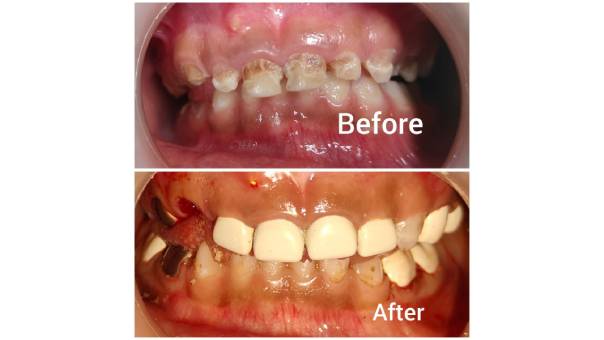
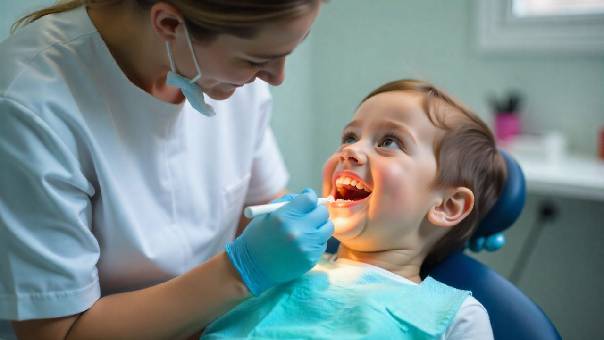
Just as importantly, the emotional transformation was evident. What started as a visit filled with anxiety and hesitation ended with laughter and confidence. The child left the clinic smiling brightly — a moment that reminded us why pediatric dentistry is one of the most rewarding branches of dental care.
Why Early Dental Visits MatterThis case perfectly illustrates why early and regular dental visits are essential for children. The American Academy of Pediatric Dentistry (AAPD) recommends that children should have their first dental visit by the age of one, or within six months after the eruption of the first tooth.
Early dental care helps in:
-
Detecting cavities before they become extensive
-
Preventing gum infections and decay
-
Guiding proper tooth eruption and jaw development
-
Reducing fear and building a positive relationship with dental care
-
Educating parents on correct brushing, diet, and oral hygiene habits
Many parents delay dental visits until visible problems arise — but prevention and early detection make a world of difference in both cost and comfort.
Common Causes of Tooth Decay in ChildrenUnderstanding what leads to early childhood caries is the first step toward prevention. Some common contributing factors include:
-
Prolonged Bottle Feeding or Night Feeding: Allowing a child to sleep with a milk or juice bottle can expose the teeth to sugars for hours, leading to decay. irritation.
-
Frequent Snacking: Sticky, sugary snacks increase acid production and plaque buildup.
-
Poor Oral Hygiene: Inadequate brushing allows bacteria to thrive.
-
Lack of Fluoride Exposure: Fluoride strengthens enamel and prevents demineralization.
-
Transmission of Bacteria: Sharing utensils or cleaning pacifiers with the parent’s mouth can transfer cavity-causing bacteria to infants.


Preventing dental issues in children begins at home. Here are simple, effective ways to protect your child’s smile:
- 1.Start Early: Begin cleaning your baby’s gums even before teeth erupt using a soft, damp cloth. Once teeth appear, use a soft-bristled toothbrush.
- 2.Supervise Brushing: Help your child brush twice a day using a pea-sized amount of fluoride toothpaste.
- 3.Limit Sugary Foods and Drinks: Encourage water over sweetened beverages. Avoid frequent snacking.
- 4.Avoid Bottle at Bedtime: Replace night bottles with water, or wean off the bottle by age one.
- 5.Schedule Regular Dental Visits: Professional cleanings and fluoride applications can help prevent decay.
- 6.Use Dental Sealants: Your dentist may recommend sealants to protect molars from decay.
One of the most overlooked factors in pediatric dental care is how children are introduced to the idea of a dental visit. Many children develop fear not from personal experience, but from what they hear at home.
Parents sometimes try to motivate their children to brush or eat less sugar by saying things like, “If you don’t brush, the dentist will give you an injection” or “You’ll have to see the dentist, and it will hurt.” While well-intentioned, these statements can create lasting fear and anxiety about dental care.
Instead, it’s important for parents to present the dental clinic as a positive and friendly place. Children should view their dentist not as someone to fear, but as a helper who keeps their teeth strong and their smiles bright.
Here’s how parents can make a difference:
-
Use Positive Language: Talk about the dentist as someone who helps clean teeth and make smiles healthy.
-
Avoid Threats or Scare Tactics: Never associate dental visits with punishment.
-
Normalize the Experience: Compare the dental visit to going to the doctor for a routine check-up or visiting a friendly office.
-
Model Calm Behavior: Children often mirror their parents’ emotions. Staying calm and cheerful helps your child feel at ease.
-
Build Familiarity: Read storybooks or show short videos about fun dental visits before the appointment.
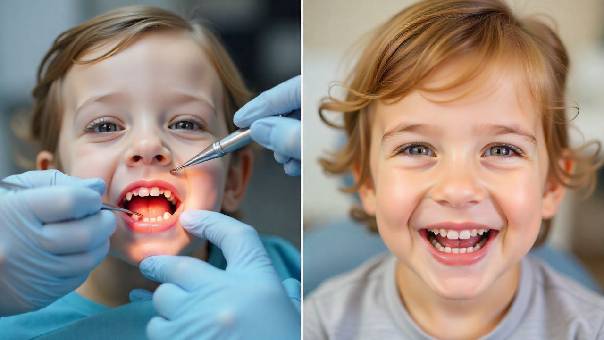
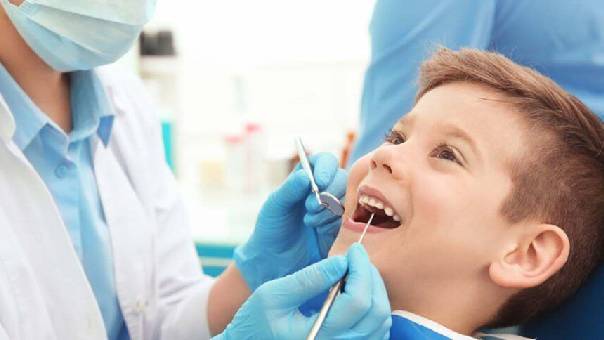
At our clinic, we go the extra mile to make each child’s experience gentle, positive, and stress-free. We create a friendly environment, use age-appropriate explanations, and ensure that even the smallest patients feel safe and cared for.
When parents and dentists work together to build this trust, children develop a lifelong comfort with oral healthcare — turning every visit into a positive and empowering experience.
The Bigger Picture: Healthy Teeth, Healthy GrowthOral health plays a vital role in a child’s overall development. Untreated decay can lead to pain, infection, difficulty eating, and speech issues. Moreover, early tooth loss can affect the alignment of permanent teeth, leading to orthodontic problems later in life.
By maintaining healthy baby teeth, parents are not just protecting smiles — they are supporting nutrition, learning, and social confidence.
Our Commitment to Pediatric Dental CareWe are deeply committed to providing comprehensive, compassionate dental care for children of all ages. Every pediatric case is handled with a focus on comfort, education, and long-term well-being. Whether it’s preventive care, restorations, or full smile rehabilitation, our goal is always the same: to ensure that every child leaves with a healthy smile and a positive attitude toward dentistry.
A healthy smile is not just about teeth — it’s about confidence, comfort, and happiness. And when it comes to children, those things matter most.
Final ThoughtsThis story is a beautiful reminder of what modern pediatric dentistry can achieve. With the right approach, even severe dental decay can be treated successfully — restoring not only teeth but also confidence and joy.
If you notice discoloration, cavities, or any discomfort in your child’s mouth, don’t wait. Early intervention can prevent complications and preserve those precious little smiles.
At our clinic, we promise to make every visit gentle, educational, and fear-free — because healthy teeth lead to happy smiles, and happy smiles build confident kids.
Credits:
Dr . R Rajesh MFDS
RCPS (Glasgow) 2019
MDS (Pediatric and Preventive dentistry - Manipal
Academy of Higher education) 1998 December
